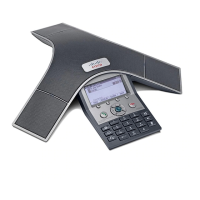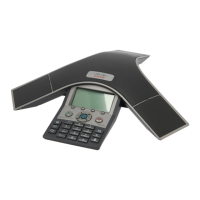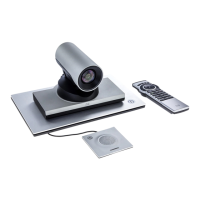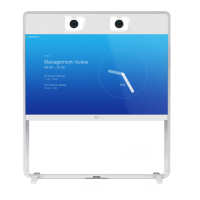4-6
Cisco Unified IP Conference Station 7937G Administration Guide for Cisco Unified Communications Manager 6.0
OL-11560-01 Rev. B0
Chapter 4 Configuring Settings on the Conference Station
Network Configuration Menu
Subnet Mask Subnet mask used by the
conference station.
1. Unlock network configuration options. For more information,
see the
“Unlocking and Locking Options” section on page 4-3.
2. Set the DHCP Enabled option to No. For more information, see
the DHCP Enabled option in this table.
3. Choose Applications > Settings > Network Configuration >
IP Subnet Mask.
4. Enter a new IP address for the subnet mask.
5. Press Validate, and then press Save.
Default Router 1 Default router used by the
conference station
(Default
Router 1).
1. Unlock network configuration options. For more information,
see the
“Unlocking and Locking Options” section on page 4-3.
2. Set the DHCP Enabled option to No. For more information, see
the DHCP Enabled option in this table.
3. Choose Applications > Settings > Network Configuration >
Default Router 1.
4. Enter a new router IP address.
5. Press Validate, and then press Save.
Domain Name Name of the Domain Name System
(DNS) domain in which the
conference station resides.
1. Unlock network configuration options. For more information,
see the
“Unlocking and Locking Options” section on page 4-3.
2. Set the DHCP Enabled option to No. For more information, see
the DHCP Enabled option in this table.
3. Choose Applications > Settings > Network Configuration >
Domain Name.
4. Enter a new domain name.
5. Press Validate, and then press Save.
DNS Server 1
DNS Server 2
DNS Server 3
DNS Server 4
DNS Server 5
Primary DNS server
(DNS
Server 1) and optional
backup DNS servers
(DNS
Server 2–5) used by the
conference station.
1. Unlock network configuration options. For more information,
see the
“Unlocking and Locking Options” section on page 4-3.
2. Set the DHCP Enabled option to No. For more information, see
the DHCP Enabled option in this table.
3. Choose Applications > Settings > Network Configuration.
4. Choose the appropriate DNS Server, and then press Select.
5. Enter a new DNS server IP address.
6. Press Validate.
7. Repeat Steps 4, 5, and 6 as needed to assign backup DNS
servers.
8. Press Save.
Table 4-3 Network Configuration Menu Options (continued)
Option Description To Change

